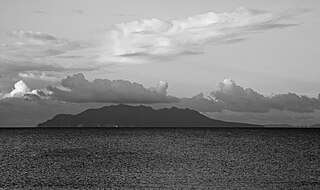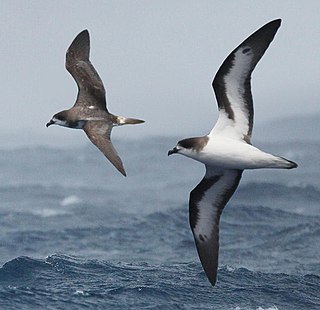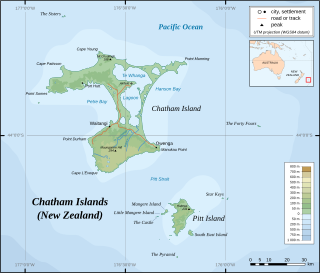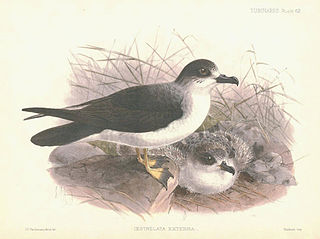Related Research Articles

Procellariiformes is an order of seabirds that comprises four families: the albatrosses, the petrels and shearwaters, and two families of storm petrels. Formerly called Tubinares and still called tubenoses in English, procellariiforms are often referred to collectively as the petrels, a term that has been applied to all members of the order, or more commonly all the families except the albatrosses. They are almost exclusively pelagic, and have a cosmopolitan distribution across the world's oceans, with the highest diversity being around New Zealand.

The gadfly petrels or Pterodroma are a genus of about 35 species of petrels, part of the seabird order Procellariiformes. The gadfly petrels are named for their speedy weaving flight, as if evading gadflies (horseflies). The flight action is also reflected in the name Pterodroma, from Ancient Greek pteron, "wing" and dromos, "runner".

Zino's petrel or freira is a species of small seabird in the gadfly petrel genus, endemic to the island of Madeira. This long-winged petrel has a grey back and wings, with a dark "W" marking across the wings, and a grey upper tail. The undersides of the wings are blackish apart from a triangle of white at the front edge near the body, and the belly is white with grey flanks. It is very similar in appearance to the slightly larger Fea's petrel, and separating these two Macaronesian species at sea is very challenging. It was formerly considered to be a subspecies of the soft-plumaged petrel, P. mollis, but they are not closely related, and Zino's was raised to the status of a species because of differences in morphology, calls, breeding behaviour and mitochondrial DNA. It is Europe's most endangered seabird, with breeding areas restricted to a few ledges high in the central mountains of Madeira.

The magenta petrel, or Chatham Island tāiko, is a small seabird in the gadfly petrel genus, Pterodroma. Found exclusively on Chatham Island, New Zealand it is one of the rarest birds in the world, believed to be extinct for over 100 years before its rediscovery in the 1970s.

Little Barrier Island, or Hauturu in Māori language, lies off the northeastern coast of New Zealand's North Island. Located 80 kilometres (50 mi) to the north of Auckland, the island is separated from the mainland to the west by Jellicoe Channel, and from the larger Great Barrier Island to the east by Cradock Channel. The two aptly named islands shelter the Hauraki Gulf from many of the storms of the Pacific Ocean.

The Westland petrel, also known as the Westland black petrel or tāiko, is a moderately large seabird in the petrel family Procellariidae from New Zealand.

The Bermuda petrel is a gadfly petrel. Commonly known in Bermuda as the cahow, a name derived from its eerie cries, this nocturnal ground-nesting seabird is the national bird of Bermuda and can be found pictured on Bermudian currency. It is the second rarest seabird on the planet and a symbol of hope for nature conservation. They are known for their medium-sized body and long wings. The Bermuda petrel has a greyish-black crown and collar, dark grey upper-wings and tail, white upper-tail coverts and white under-wings edged with black, and the underparts are completely white.

The Chatham petrel or ranguru (Maori) is a medium-sized, grey, white and black gadfly petrel. It is endemic to the Chatham Islands, New Zealand, and until recently was restricted to the 218-hectare Rangatira or South-East Island.

Hokorereoro, Rangatira, or South East Island is the third largest island in the Chatham Islands archipelago, and covers an area of 218 hectares. It lies 800 kilometres (497 mi) east of New Zealand's South Island off the south-east coast of Pitt Island, 55 kilometres (34 mi) south-east of the main settlement, Waitangi, on Chatham Island.

The Sisters / Rangitatahi is a group of three islands located 16 kilometres (10 mi) north of Cape Pattison, Chatham Island. They are the northernmost members of the Chatham Archipelago, located 800 kilometres (497 mi) east of New Zealand's South Island.

The Chatham Island pigeon or parea is a bird endemic to the Chatham Islands in New Zealand. Growing to 800g in weight and 55 cm in length, the Chatham Island pigeon is closely related to the kererū or New Zealand pigeon, the only other species in the genus Hemiphaga.

The Juan Fernández petrel is a species of seabird in the family Procellariidae. It nests on a single island off the coast of Chile, in the Juan Fernández Archipelago. It was previously classified as a subspecies of the white-necked petrel, which is found in tropical waters of the Pacific and Indian Oceans.

Gould's petrel is a species of seabird in the family Procellariidae. The common name commemorates the English ornithologist and bird artist John Gould (1804-1881).

Pycroft's petrel is a species of seabird in the petrel and shearwater family Procellariidae.

The grey-faced petrel is a petrel endemic to the North Island of New Zealand. In New Zealand it is also known by its Māori name ōi and as a muttonbird.
Imber's petrel is an extinct seabird of gadfly petrel from the Chatham Islands. The species' epithet commemorates New Zealand ornithologist Mike Imber (1940–2011).
Creophilus rekohuensis is a beetle of the Staphylinidae family, subfamily Staphylininae. This species occurs only on some small predator-free islands in the Chatham Islands, New Zealand, where it lives in seabird burrows. Its name derives from Rekohu, the Moriori name for Chatham Island.

Moutere Hauriri / Bounty Islands Marine Reserve is a marine reserve covering an area of 104,626 hectares around New Zealand's Bounty Islands. It was established in 2014 and is administered by the Department of Conservation.
References
- ↑ "Chatham Islands habitats and protected areas". www.doc.govt.nz (in en-nz). Retrieved 30 August 2019.
{{cite web}}: CS1 maint: unrecognized language (link) - ↑ "Chatham Island Taiko". Ocean Wanderers. Retrieved 14 December 2009.
- ↑ "Chatham Island Taiko Trust" . Retrieved 14 December 2009.
- ↑ Houston, Dave (12 June 2012). "Parea – the Chatham Island pigeon – Chatham Islands, New Zealand" (in en-NZ). Retrieved 30 August 2019.
{{cite web}}: CS1 maint: unrecognized language (link) - ↑ Aikman, Hilary; Miskelly, Colin (2004). "Birds of the Chatham Islands" (PDF). DOC.
- ↑ Johnston, Rachel B.; Bettany, Susan M.; Ogle, R. Mike; Aikman, Hilary A.; Taylor, Graeme A. & Imber, Michael J. (2003). "Breeding and fledging behaviour of the Chatham Taiko (Magenta Petrel) Pterodroma magentae, and predator activity at burrows" (PDF). Marine Ornithology. 31: 193–197.
- ↑ Houston, Dave (12 June 2012). "Parea – the Chatham Island pigeon – Chatham Islands, New Zealand" (in en-NZ). Retrieved 30 August 2019.
{{cite web}}: CS1 maint: unrecognized language (link)
44°04′S176°36′W / 44.067°S 176.600°W Coordinates: 44°04′S176°36′W / 44.067°S 176.600°W
